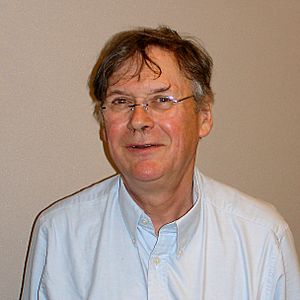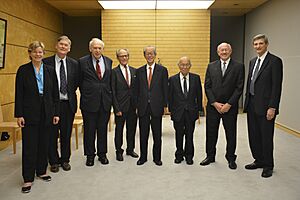Tim Hunt facts for kids
Quick facts for kids
Sir Tim Hunt
FRS FRSE FMedSci MAE
|
|
|---|---|

Hunt at the UCSF in 2009
|
|
| Born |
Richard Timothy Hunt
19 February 1943 |
| Education |
|
| Alma mater | University of Cambridge (BA, PhD) |
| Known for | Cell cycle regulation |
| Spouse(s) |
Mary Collins
(m. 1995) |
| Children | Two daughters |
| Awards |
|
| Scientific career | |
| Fields | Cell cycle (Biochemistry) |
| Institutions |
|
| Thesis | The synthesis of haemoglobin (1969) |
| Doctoral advisor | Asher Korner |
| Doctoral students | |
Sir Richard Timothy Hunt, born on February 19, 1943, is a famous British biochemist. He won the 2001 Nobel Prize in Physiology or Medicine for his amazing discoveries about how cells divide. He shared the prize with his colleagues Paul Nurse and Leland H. Hartwell.
In the early 1980s, while studying sea urchin eggs, Hunt discovered a special protein he named cyclin. He noticed that the amount of this protein went up and down in a cycle as cells divided. This discovery was a huge step in understanding how life works at the smallest level.
Contents
Early Life and Education
Tim Hunt was born in Neston, England. His father, Richard William Hunt, was a university lecturer, and his mother, Kit Rowland, was the daughter of a timber merchant. In 1945, his family moved to Oxford.
At age eight, Hunt went to the Dragon School. It was here that his science teacher, Gerd Sommerhoff, first sparked his interest in biology. He later attended Magdalen College School, Oxford, where his love for science, especially chemistry and zoology, grew even stronger.
In 1961, Hunt began studying Natural Sciences at Clare College, Cambridge. After graduating in 1964, he started working in the university's Department of Biochemistry. He became very interested in haemoglobin, the protein in red blood cells that carries oxygen. This interest led him to work in a lab in New York for a few months. He earned his PhD in 1968 for his research on how haemoglobin is made.
Career and Research
Early Discoveries
After earning his PhD, Hunt continued his research. He worked with other scientists in both New York and Cambridge. His team made important discoveries about how protein creation is controlled inside cells.
Hunt often spent his summers at the Marine Biological Laboratory in Woods Hole, Massachusetts. This place was perfect for scientists studying mitosis (cell division). It had a large supply of sea creatures like surf clams and sea urchins. These animals were great for research because their embryos (early-stage babies) were easy to study under a microscope.
The Discovery of Cyclins
The big breakthrough came in the summer of 1982 at Woods Hole. Hunt was studying fertilized sea urchin eggs to see how they divided and grew. He used a special technique to track the new proteins being made inside the eggs.
By taking samples every 10 minutes, he noticed something fascinating. One protein would build up and then suddenly disappear right when the cell was about to divide. Because its levels changed in a cycle, he named this protein cyclin.
This discovery was very important. Hunt and other scientists later found that cyclins are present in almost all living things, from frogs to humans. They work by teaming up with other molecules called cyclin-dependent kinases (CDKs). Together, they act like a switch that tells a cell when it's time to divide. This process is called the cell cycle, and it's essential for growth and life.
Later Career
In 1990, Hunt joined the Imperial Cancer Research Fund in the United Kingdom. There, he studied what goes wrong in cells to cause cancer. Cancer is a disease where cells divide uncontrollably, and understanding cyclins is key to understanding cancer.
Hunt has also been a mentor to many young scientists throughout his career. He believes in giving young people the freedom to explore their own ideas. He co-wrote a book called The Cell Cycle: An Introduction, which was published in 1993. He is now an Emeritus (retired but still honored) Group Leader at the Francis Crick Institute.
Speaking About Science
After winning the Nobel Prize, Hunt traveled the world to talk about science. He often told his audiences that science should be fun and that luck plays a part in discovery. He encourages young people to pursue science and believes in their potential to make great discoveries.
2015 Remarks
In 2015, Hunt was at a conference for science journalists in South Korea. During a lunch, he made some comments that were intended to be a joke. However, when parts of his speech were shared online, many people found them offensive.
The comments caused a lot of debate, and Hunt later apologized. He said his words were not meant to be serious and were taken out of context. As a result of the controversy, he stepped down from several honorary positions at universities and research institutes.
Awards and Honors
Tim Hunt has received many awards for his work.
- In 1991, he was elected a Fellow of the Royal Society (FRS), one of the highest honors for a scientist in the UK.
- In 2001, he, along with Leland Hartwell and Paul Nurse, won the Nobel Prize in Physiology or Medicine. The Nobel committee honored him for his "discovery of cyclins, proteins that regulate the CDK function."
- In 2006, he received the Royal Medal from the Royal Society for his important contributions to science.
- In 2006, he was knighted by the Queen for his services to science, which is why he is called Sir Tim Hunt.
Personal Life
Hunt is married to Mary Collins, who is also a scientist. They have two daughters.
See also
 In Spanish: Tim Hunt para niños
In Spanish: Tim Hunt para niños


